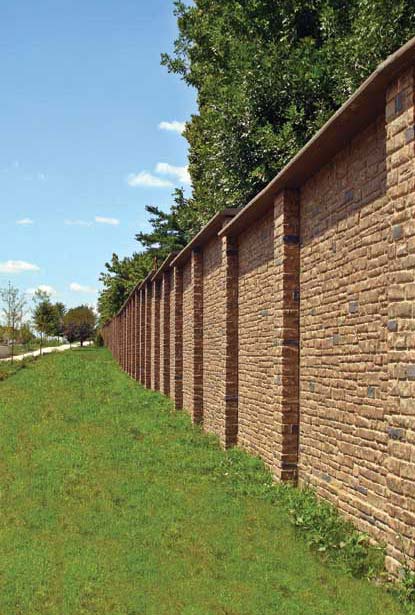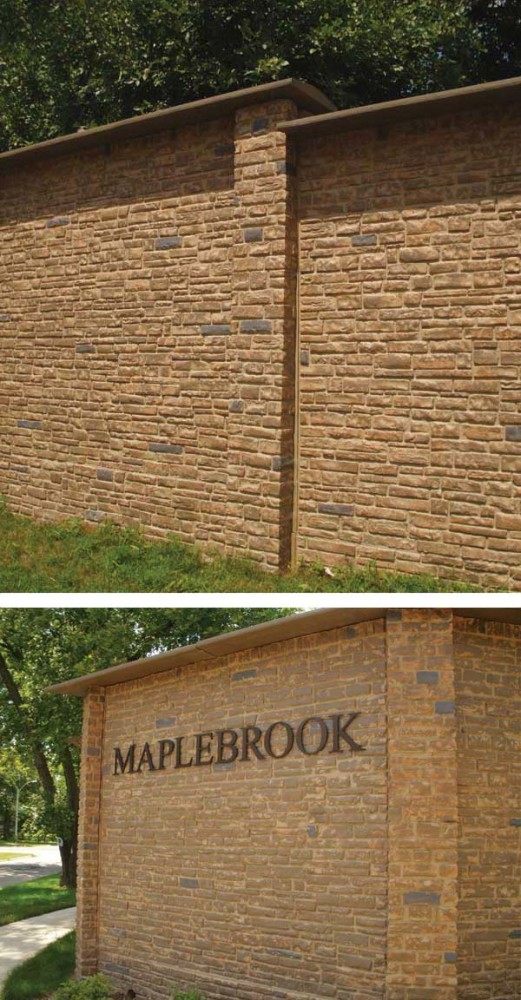
by Tom Kuckhahn, PE
Federal, state, and local specifiers continually seek affordable, durable, and aesthetically pleasing wall solutions to border bustling highways and adjacent neighborhoods. The principal purpose of these is typically to provide citizens with a visual barrier to the highway and sometimes to mitigate traffic noise.
Today, highway barriers cover thousands of miles of federal roadways. When the walls first began to appear in the 1960s, they were modeled after wooden fences. Now, things have changed––according to the Federal Highway Administration (FHWA), almost half of the highway walls constructed in North America to date are made of concrete. (See Section 5, “Noise Barrier Materials and Surface Treatments,” in the U.S. Department of Transportation (DOT) Federal Highway Administration’s (FHWA’s) Noise Barrier Design Handbook.) While wood, metal, brick, and masonry block also comprise some of the roadway walls sprawling the country, concrete panels have emerged as a preferred solution that meets many affordability, durability, and aesthetic specifications and preferences.
Limiting the noise
In addition to functioning as a visual shield, highway walls serve as barriers to help break the path of sound traveling from freeways to neighboring homes and buildings. Most highway noise barriers force sound to travel a longer path over and around the barrier. Effective highway walls typically reduce sound levels by five to 10 dB. Since sound levels are measured using a logarithmic scale, a reduction of nine decibels is equivalent to elimination of more than 50 percent of the unwanted sound. (See “Highway Traffic Noise Barriers at a Glance” from Keeping the Noise Down: Highway Traffic Noise Barriers by the U.S. DOT’s FHWA.)
Sound transmission class (STC) is a single number rating of a material’s ability to resist airborne sound transfer at frequencies of 125 to 4000 Hz. In general, a higher STC rating blocks more noise from transmitting. According to the results of a sound transmission test conducted by Element Materials Technology in Saint Paul, Minnesota, a 152-mm (6-in.) thick concrete panel weighing 547 kg (1205 lb) has an STC rating of 50, an outdoor-indoor transmission class (OITC) rating of 45, and a deficiencies rating of 22. (Element Materials Technology [formerly Stork Twin City Testing Corp.] presented “Sound Transmission Class Testing Ledge Stone Panel,” to a manufacturer on Sept. 4, 2009.)
These ratings meet the sound-limiting specifications for highway wall barriers. The STC value was obtained by applying the transmission loss (TL) values to the reference contour of ASTM E413-04, Determination of Sound Transmission Class.

The actual transmission loss at each frequency was calculated by the following equation:
TL = NR + 10logS – 10logA2
TL = transmission loss (dB)
NR = noise reduction (dB)
S = surface area common to both sides (sf)
A2 = sound absorption of the receiving room with the sample in place (sabins)
OITC procedure ASTM E1332-03, Determination of Outdoor-Indoor Transmission Class, was followed in every respect. Basically, OITC was calculated by using the sound transmission loss values in the 80 to 4000 Hz range as measured in accordance with ASTM E90-04, Standard Test Method for Laboratory Measurement of Airborne Sound Transmission Loss of Building Partitions and Elements. These transmission loss data are then used to determine the A-weighted sound level reduction of the specimen for the reference source spectrum specified in ASTM E1332, Table 1. The appropriate calculations were made to determine the OITC value.
Standing its ground
Durability is a critical factor specifiers must evaluate to determine what kind of material should be used for a municipality’s highway walls. Durability depends on a structure’s ability to withstand extreme loads, and is often reflected by the ability to resist bending. Measured by loading un-reinforced panels, flexular strength is expressed as the modulus of rupture (MR) in pounds per square inch (psi). The results of such tests enable designers and constructors to assess the resistance of highway walls to wind and seismic loads.
Concrete construction is, in general, exceptionally strong. It gains most of its strength in the first 28 days, but it continues to gain strength over its life. Hydration causes the compounds in cement to elongate. As the compounds lengthen, they intertwine and create an impermeable surface. According to Precast/Prestressed Concrete Institute (PCI), precast easily achieves a strength of 34,474 to 48,263 kPa (5000 to 7000 psi) or more (See “Sustainability FAQ” by the Precast/Prestressed Concrete Institute (PCI).)
Not your fair-weathered wall
Due to their durability, precast highway walls are able to withstand varying weather conditions better than their wooden counterparts. Wood is porous and, as a result, tends to absorb moisture, which causes expansion. The wood contracts as it dries out. Frequent expansion and contraction eventually contributes to gaps between planks for mildew to grow.
Wooden sound walls typically require significant maintenance after five or 10 years because of weather degradation from sun, water, and salt. Sun bleaches paint and stains, quickly eliminating the protective wall coatings. Once the stains are gone, water easily seeps into the wood panels. Over time, this results in significant structural degradation. In snowy climates, the salt wash that results from snow plows introduces chloride to the wood, which further degrades the panels. Cold climate regions face the threat of additional wear and tear on their walls as a result of moisture freezing and thawing.




